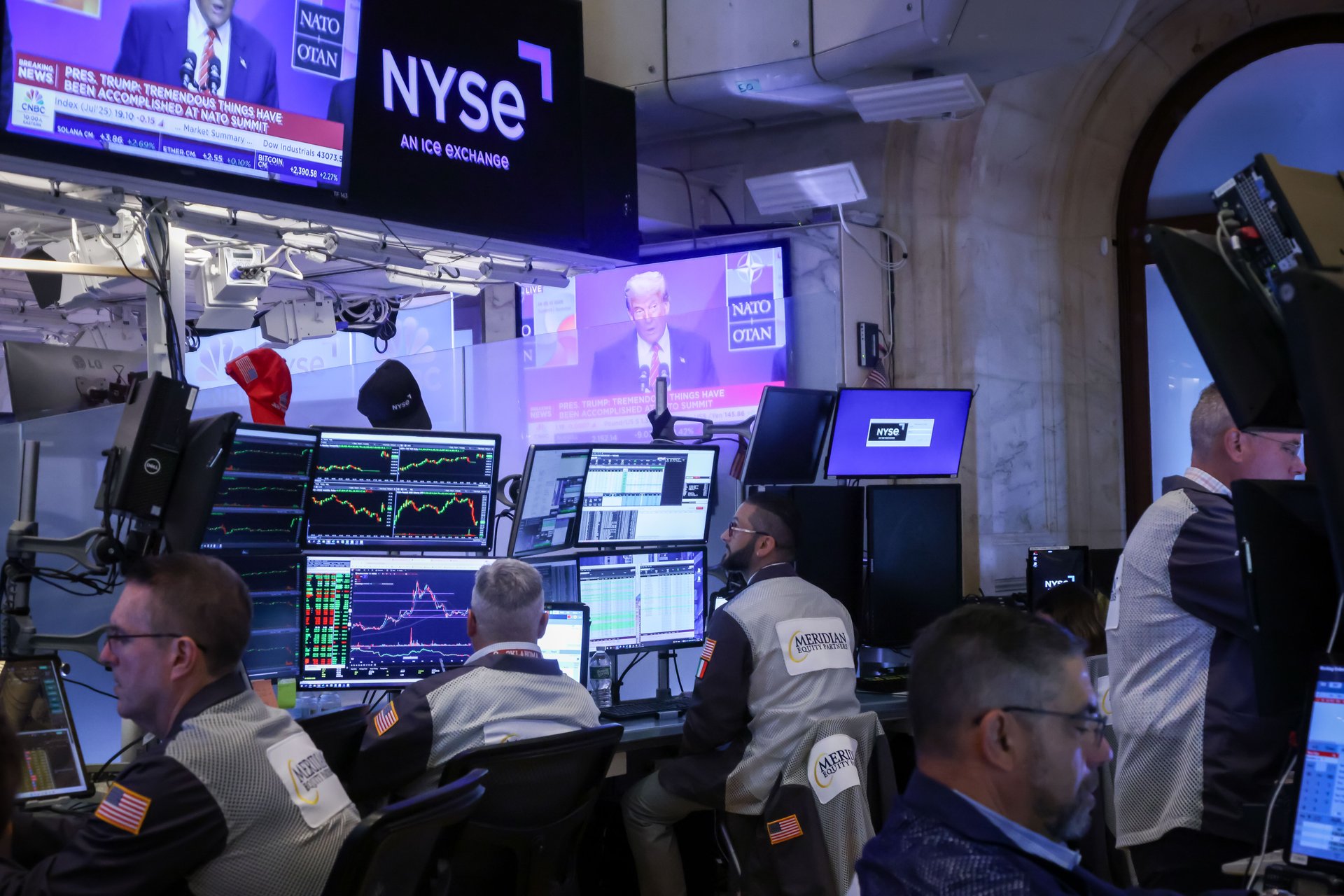The S&P 500 hit a record intraday high: What’s driving the surge
The S&P 500 hit an intraday record as interest rate cut hopes, geopolitical calm, and tech earnings fuel a summer rally

Michael Nagle/Bloomberg via Getty Images
Just months after trade wars, inflation worries, and geopolitical flare-ups rattled investors, the S&P 500 briefly ticked above the previous intraday high of 6,147.43 in February 2025 but closed below the all-time high of 6,144.15. Stocks have been buoyed by cooling tensions abroad, softer inflation readings, strong tech earnings, and renewed hopes that the Federal Reserve might actually cut interest rates this year.
The Dow Jones Industrial Average was up about 350 points, or about 0.8%, in Thursday afternoon trading, while the Nasdaq was up about 0.9% and the S&P 500 was up 0.7%. The benchmark index hovered around 6,100 on Thursday afternoon, lifted by gains in tech and a dip in oil prices after a fragile ceasefire between Israel and Iran provided a sigh of relief after weeks of geopolitics whip-sawing portfolios.
Oil prices dipped roughly 6% over two sessions in the steepest two-day decline since March 2022, while bond yields steadied and equity markets shook off the jitters.
That cooling of Middle East tensions helped deflate one of the summer’s biggest market risks, while a weaker U.S. dollar — now at a three-year low — further eased pressure on equities. Bond yields, too, have drifted lower in recent sessions.
Underpinning the rally is a market narrative that’s shifted — once again — toward soft landing optimism.
Federal Reserve Chair Jerome Powell reiterated this week that the central bank remains “data dependent” and continues to signal a “wait-and-see” stance on interest rate cuts, confirming that officials will rely on data that shows the impact of President Donald Trump’s tariffs. Investors are softly pricing in a July rate cut — still seen as unlikely with around 20% odds — but are now pricing in better-than-even odds of a move by September (over 50%). With inflation easing and labor markets showing just enough softness to justify a dovish pivot, investors are warming back up to the idea that the Fed might actually stick the landing.
Under the surface, earnings season has continued to deliver just enough good news to sustain the rally. At current levels, the S&P 500 is trading about 22 times forward earnings — high by historical standards, but not outrageous in a low-rate world that still favors growth over value.
Big Tech, in particular, remains a pillar of strength, with Nvidia stock again hitting record highs this week. The AI-fueled enthusiasm hasn’t faded, and investors appear content to ride the momentum even as valuations stretch. Altogether, tech now makes up more than a third of the index, and its strength has largely masked weakness elsewhere.
That masking matters. The rally’s breadth remains thin: About one-third of S&P 500 stocks are still trading below their 50-day moving averages, signaling that much of the recent upside has been concentrated in a few familiar names. Small-cap stocks, too, have been left out. The Russell 2000 is still down for the year, and the Dow has underperformed, as well. Investors may be chasing growth, but they’re not betting broadly on the economy. Interest-rate-sensitive sectors — such as regional banks, industrials, and materials — lag, pointing to skepticism that the expansion will persist beyond 2025.
And while some data points to cooling inflation, the broader economy isn’t firing on all cylinders. Job openings have fallen, wage growth is slowing, and delinquencies are on the rise — hinting that the landing could still get bumpy. The Fed may not have the luxury of waiting for ideal conditions if those cracks widen, and that complicates the central bank’s calculus heading into the third quarter.
Analysts at UBS have warned that markets are priced for perfection heading into a potentially volatile summer. Any slip — whether from macroeconomic data, a surprise Fed move, or new geopolitical flare-ups — could trigger a sharp repricing. BCA Research’s Peter Berezin went further, suggesting a 25% pullback isn’t out of the question if economic conditions weaken or the Fed keeps rates elevated longer than expected.
In the meantime, investors are watching closely.
Thursday’s rally puts the S&P 500 within a few good trading sessions of a record close, and even small gains from here would be an exclamation point on a market that has repeatedly defied skeptics. Whether that next leg higher is built on fundamentals or just momentum remains to be seen. But for now, the bulls are balancing with confidence — just don’t look down.
In a market that’s been defined by its ability to climb the wall of worry, it turns out all it took was a little geopolitical breathing room, a softer CPI reading, and a few strong AI earnings to put records back on the table. But for now, the bulls are confidently navigating a familiar tightrope — buoyed by a rare convergence of geopolitical calm, softer inflation data, and resilient AI-fueled earnings.
Wall Street may have a short memory, but it’s proving once again that when the runway is clear, it can sprint toward new highs.
